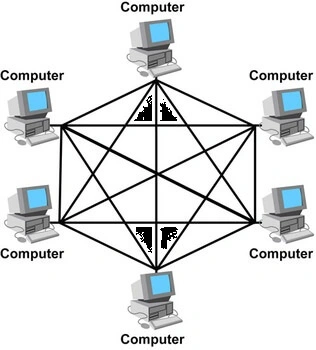Introduction
In the ever-evolving landscape of networking, understanding network topologies is crucial for anyone involved in IT and network design. From simple bus layouts to complex mesh frameworks, each topology offers unique advantages and challenges.
This article delves into the core concepts of network topologies, focusing on the transition from traditional bus designs to advanced mesh systems, and how they impact modern networking.
What are Network Topologies?
Network topologies refer to the arrangement or layout of different elements (links, nodes, etc.) in a computer network. It’s a structural framework outlining how the network components are interconnected and communicate with each other. Understanding network topologies is essential for designing and maintaining reliable, efficient, and secure networks.
The main types of network topologies include:
Bus Topology
Bus topology refers to a specific kind of network configuration where each computer or network device is connected to a single main cable or bus.
The characteristics and key points of bus topology include:
- Single Main Cable: The central cable is the backbone of the network and is known as the bus.
- Terminators: Each end of the bus has a terminator to prevent the signal from reflecting back on the bus.
- T-Connectors: Devices are connected to the bus using T-connectors or other types of connectors.
- Data Transmission: Data sent by a device is available to all other devices on the bus but is only accepted by the device for which it is intended. This is usually managed by using unique addresses for each device.
- Easy to Install: Bus topology is relatively easy and inexpensive to install for small networks.
- Limited Cable Length and Number of Stations: There is a limitation on the number of stations that can be attached and the total length of the main cable.
- Vulnerability: If the main cable fails, the entire network goes down. This makes bus topology less ideal for large networks.
- Maintenance and Troubleshooting: It can be more difficult to isolate problems in a bus network.
- Used in Small Networks: Due to its simplicity and cost-effectiveness, bus topology is often used in small networks, such as in small office or home networks.
- Legacy Technology: In modern networking, bus topology has largely been replaced by more advanced configurations like star topology or mesh topology due to their higher reliability and performance. However, understanding bus topology is still fundamental in network theory and education.
This topology played a significant role in the early days of local area networking, particularly with technologies such as Ethernet in its initial forms, but has since seen a decline in usage in favor of more robust solutions.
Ring Topology
Ring topology is a network configuration where each device is connected to exactly two other devices, forming a single continuous pathway for signals through each device – a ring. Data travels from one device to another, with each device having the capability to receive and transmit the signal.
Advantages, and Disadvantages:
Features of Ring Topology
- Sequential Data Flow: Data in a ring topology travels in a unidirectional or bidirectional manner, with each device processing and retransmitting the data to the next.
- Token Passing: Many ring networks use a token-passing mechanism for data transmission. A token, or a small data packet, circulates around the network; a device can send data only when it captures the token.
- Equal Access: Each device has equal access to the network.
- Dependency on Neighbors: Each device in the network depends on its immediate neighbors to transmit and receive data.
Advantages
- Predictable Network Performance: The token-passing mechanism can prevent network collisions and can offer predictable network performance under heavy loads.
- Equal Opportunity for Access: Each device gets an equal opportunity to transmit data.
- Simplified Data Paths: Since the data moves in a ring, the data paths are typically more straightforward than in a more complex network topology.
Disadvantages
- Failure in the Ring: A single failure in any cable or device can break the loop and take down the entire network.
- Troubleshooting Difficulties: It can be more challenging to isolate faults in a ring network.
- Scalability Issues: Adding or removing devices can disrupt the network, and the network’s performance can degrade as more devices are added.
Applications
- Ring topology was more common in older networks, such as IBM’s Token Ring network.
- Today, it’s less common in LANs (Local Area Networks) but might be found in some WANs (Wide Area Networks) or in specialized applications like certain types of SONET networks.
- How to setting the stage for widespread internet adoption.
- Designing and setting up networks that meet the organization’s needs.
- Computers and other devices to communicate over the internet and distinguish themselves in a vast network.
Star Topology
Star topology refers to a type of network configuration in which each network node (like computers, printers, servers, etc.) is individually connected to a central node or hub. This central hub acts as a conduit to transmit messages. The star topology is one of the most common network topologies used in LANs (Local Area Networks).
Some key characteristics of star topology:
- Centralization: The central hub is the key to the network’s functionality. It manages and controls all the traffic in the network.
- Dependence on the Hub: If the central hub fails, the whole network goes down, making the network heavily dependent on the performance and reliability of the hub.
- Ease of Installation and Scalability: Adding or removing devices is easy and generally does not affect the rest of the network. This makes the star topology scalable.
- Cable Length: Each device requires its own cable to connect to the hub, which can result in the usage of more cabling than in other topologies like ring or bus.
- Performance: The performance is usually high as there is a direct connection between each device and the hub. However, if the hub is overloaded, this can become a bottleneck.
- Troubleshooting and Maintenance: It’s easier to troubleshoot and maintain since each device is connected to the hub independently. If one connection fails, it does not affect the others.
- Cost: The cost can be higher than other topologies due to the need for more cabling and the cost of the hub.
- Use Cases: It’s commonly used in small to medium-sized networks where performance and ease of installation are important, but the high cost and central dependency are not major concerns.
This topology is favored for its simplicity and efficiency in handling data traffic, but the dependency on the central hub is its primary vulnerability.
Mesh Topology
Mesh topology in the context of computer networking refers to a type of network design where each node (which could be a computer, router, switch, or other device) is interconnected with one or more other nodes. This creates a network that often resembles a mesh-like structure, hence the name.

There are two primary types of mesh topologies:
- Full Mesh Topology: In this arrangement, every node is directly connected to every other node in the network. This setup provides excellent redundancy and reliability, as data can be transmitted across multiple paths from one node to another. If one link fails, data can still reach its destination through alternative routes. However, full mesh topologies are complex and expensive to implement, especially in large networks, due to the high number of connections required.
- Partial Mesh Topology: In a partial mesh, not all nodes are interconnected. Some nodes may be connected to all others, but others might only be connected to a few. This is a more cost-effective approach compared to a full mesh and still offers better redundancy than simpler topologies like a star or bus, but it doesn’t provide the same level of redundancy as a full mesh.
Advantages of Mesh Topology:
- Reliability and Redundancy: Due to multiple pathways, mesh networks are highly resilient to failures. If one path fails, data can be rerouted through another.
- Fault Tolerance: The network can continue to operate even if one or more connections fail.
- Enhanced Privacy and Security: Direct connections between devices can enhance security.
- Scalability: It’s relatively easy to add more nodes to the network.
Disadvantages of Mesh Topology:
- Cost and Complexity: Requires more cabling and network infrastructure, making it expensive and complex to implement and manage.
- Maintenance Challenges: The complexity of the network can make troubleshooting and maintenance more difficult.
Tree Topology
In this topology, there is a single root node, typically a central hub, switch, or router, from which branches or tiers of nodes extend. Each node in the network is connected to only one other node higher in the hierarchy, except for the root node.
Characteristics of Tree Topology:
- Hierarchical Structure: The network is arranged in a hierarchy where each level can have multiple nodes, but each node is connected to only one parent node.
- Root Node: This is the topmost node, usually a more powerful computer, switch, or router, serving as the point of origin for data transmission.
- Branch Nodes: Nodes that are connected to the root node or other intermediate nodes. They can be workstations, repeaters, hubs, or switches.
- Scalability: Tree topology is scalable as more nodes can be easily added to the network. It can support more nodes than a bus topology.
- Point-to-Point Wiring for Individual Segments: Each segment in the tree topology has a point-to-point wiring to the central node it connects to.
Advantages of Tree Topology:
- Scalable and Expandable: It’s easier to expand compared to some other topologies like bus or ring.
- Well-Organized: The hierarchical structure makes it easy to manage and maintain.
- Error Detection and Isolation: It is easier to detect and isolate faults in a tree topology due to its segmented structure.
- Effective for Large Networks: Suitable for large networks spread over a wide area.
Disadvantages of Tree Topology:
- Dependency on Root Node: The entire network depends on the root node. If the root node fails, the entire network can be affected.
- Complexity: The network can become complex as it grows, making the management and cabling more difficult.
- Cost: The cost of installation and maintenance can be higher compared to simpler topologies like bus or ring due to more cabling and the need for more hubs, switches, or routers.
In the realm of network structures, Tree Topology stands as a testament to hierarchical order and scalability, where each node reaches upwards to a singular, pivotal root, ensuring organized data flow and expandability, yet remains tethered to the Achilles’ heel of its central node’s vulnerability



